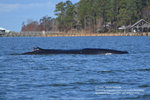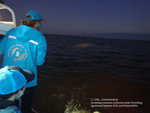



FAIRHOPE – Marine scientists are working to determine what caused a 33.5-foot male sperm whale to come into Mobile Bay where it had to be euthanized Wednesday, Nov. 25.
On Thursday and Friday, biologists and others from the Dauphin Island Sea Lab, Gulf World Marine Institute, the Emerald Coast Wildlife Refuge and the Institute for Marine Mammal Studies studied the whale’s remains to determine why the animal strayed about 100 miles from its usual habitat and stranded itself several times.
The study, or necropsy, found no obvious signs of injury. Samples taken from the whale will be sent to laboratories to be tested for infections, toxic substances or other factors that might have led to the animal’s death, according to a statement by the Dauphin Island Sea Lab.
Some samples will be tested at DISL and some sent to labs around the country, the statement said. The tests will check for organ function, nutrition, diseases, toxin exposures and other factors.
The whale was first seen on Thursday, Nov. 19. This was the first time a sperm whale was known to have come into Mobile Bay, Ruth Carmichael, senior DISL marine scientist, said.
She said a team of biologists and veterinarians followed the whale for almost a week before determining that the animal would have to be killed.
“Euthanasia was deemed the best option for this animal who was suffering and was unable to swim and survive any longer in the wild,” Carmichael said. “The process, I can tell you, went extremely smoothly. We were a little bit concerned, of course, there was some bad weather that was supposed to come in, but we were really fortunate to have a window this morning when all of the conditions were right so we could make this possible and administer the medications that were necessary.”
The whale stranded itself several times and did not appear try to leave the bay, swimming up as far north as Montrose. Biologists, veterinarians and other experts followed and studied the whale as it moved around Mobile Bay.
Carmichael said the whale’s size made it difficult to determine its condition while the team was following the animal.
“It’s so hard when an animal is this big, because it’s just big enough that it strands in water that’s slightly too deep to give us good visibility of the animal until we can actually get it out of the water and that makes it also more challenging to diagnose or to try to speculate on the cause of death,” she said.
At about 30,000 pounds, the whale was too big to move back into the Gulf, according to a statement by the Dauphin Island Sea Lab. Sperm whales’ natural range would be at least 100 miles out in the Gulf in water at least 200 meters, 660 feet, deep. The whale could not be towed or carried that distance without causing more injuries.
Carmichael said sample results from the necropsy could take several weeks to confirm.
“If it is something like a disease, whether it’s biological or viral or fungal, that’s the kind of thing where it will take even longer because we have to send samples out for analysis before we can get a definitive answer back on some of those things,” she said. This is going to be a huge undertaking. So, this is how we get to spend our holidays, but, then, it may be weeks before we can actually have a better answer. If it is not something that’s obvious. If it’s something that requires additional sampling or testing, then it may take a little more time.”
The whale was described as emaciated while it was swimming in the bay. The necropsy found little food in the that the animal’s stomach except some remains of squid beaks and crab shells. Both from animals that are part of a sperm whale’s regular diet.
Carmichael said the issue involves more than one whale.
“These are really important questions,” she said. “It’s about the health of our environment and our system and we definitely want to make sure we can bring the answers to everyone as soon as we can.”
Sperm whales are an endangered species. About 1,000 are believed to be in the northern Gulf of Mexico, she said.